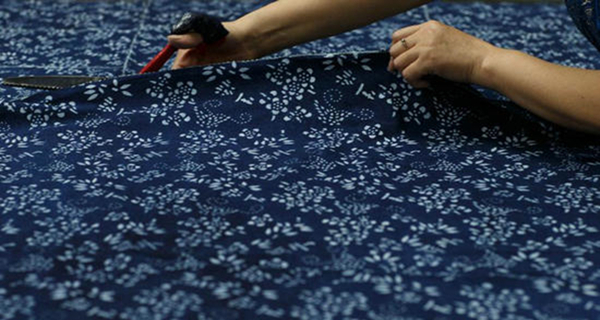Natural indigo-dye has a long history in China, dating back to the Qin and Han Dynasties (BC 221-220), and indigo-dyed cloth had been used as a main material for clothes for at least 1,000 years. Natural indigo is extracted from four kinds of plants: Strobilanthes cusia, Indigofera tinctoria, Polygonum tinctorum and Isatis tinctoria. In Chinese, any plant that can be used to extract indigo is generally named "Lan Cao" (literally, "blue plants"). The cloth dyed by these plants always retains a faint fragrant smell and is naturally mothproof.

Natural indigo-dyed cloth has two pattern categories: one is a white design printed on a blue background; the other has blue patterns on white. Patterns on both sides of the cloth developed in recent years. The themes are centered on plants, mythical and auspicious animals and characters in stories that bear Chinese people's good wishes for their lives.
Creating indigo-dyed cloth: Making indigo-dyed cloth includes the following steps:
1. Carve the patterns (plants or animals) deeply into a special paper board made with many layers. This requires the craftsman to hold the carving knife vertically to ensure the patterns are the same on each layer.
2. Polish the surface of the carved paper board with a pebble, and then paint boiled tung oil onto the board.
3. Make a white resistant paste by blending soybean meal, water and lime together.
4. Put the carved board onto a soaked white cotton cloth and paint the board with the white paste.
5. Hang the white cloth, which has been printed with the resistant paste, until it becomes dry. The material must avoid direct sunshine.
6. Put the white cloth into the dye vat for 20 minutes and expose it to the open air for 30 minutes to let the dye oxidize. This step usually needs to be repeated 6 to 7 times until the cloth achieves the correct depth of blue color.
7. Dry the dyed cloth in the open air on drying racks.
Nantong indigo-dyed cloth from the time of the Ming (1368-1644) and Qing (1644-1911) dynasties, Nantong in Jiangsu province has been the major supplier of indigo dyed cloth. In May 2006, the blue dye technique was approved as a national intangible cultural heritage by the State Council. In Nantong, the entire process is finished by hand.
Source: chinaclture.org



